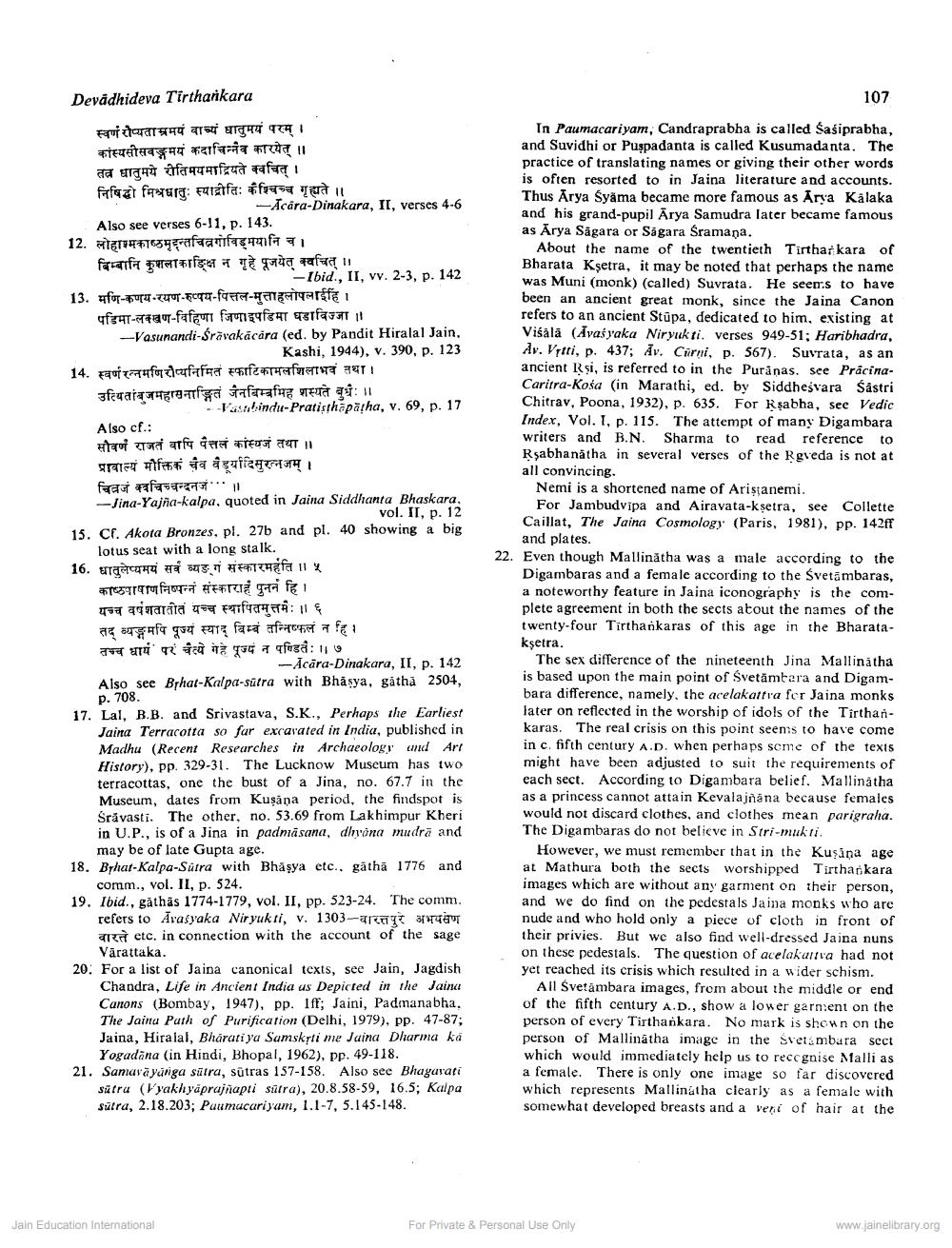________________
Devadhideva Tirthankara
स्वर्ण रौप्यताम्रमयं वाच्यं धातुमयं परम् । स्वयं कदाविकारयेत् ॥ तत्र धातुमये रीतिमयमाद्रियते क्वचित् । निषिद्धो मिश्रधातुः स्याद्रीतिः कैश्चिच्च गृह्यते ॥ -Acara-Dinakara, II, verses 4-6
Also see verses 6-11, p. 143. 12. लोहाश्मकाष्ठमृदन्तचिन गोविड्मयानि च । कुन हे पूजयेत् स्वचित् ॥ -Ibid., II, vv. 2-3, p. 142
13. मणि-कणय रयण रुप्पय वित्तल-मुत्तालोपलाईहि । पडिमा लक्खण विहिणा जिणाइपडिमा घडाविज्जा | -Vasunandi-Sravakäcära (ed. by Pandit Hiralal Jain, Kashi, 1944), v. 390, p. 123 14. स्वर्णरत्नमणिरोप्यनिर्मित स्फाटिकामलशिलाभवं तथा । उत्थितां बुजमहासनाङ्गितं जैनबिम्बमिह शस्यते बुधैः ॥ Vastbindu-Pratisthapatha, v. 69, p. 17
Also cf.:
सौवर्ण राजतं वापि पैत्तलं कांस्यजं तथा ॥ प्रावाल्य मौक्तिकं चैव वैडूर्यादिसुरत्नजम् । चित्रजं क्वचिच्चन्दनजं
॥
-Jina-Yajña-kalpa, quoted in Jaina Siddhanta Bhaskara.
vol. II, p. 12 showing a big
15. Cf. Akota Bronzes, pl. 27b and pl. 40 lotus seat with a long stalk..
16. धातुलेप्यमयं सर्वं व्यङ्गं संस्कारमर्हति ॥ ५
काष्ठपाषाण निष्पन्नं संस्काराहं पुननं हि । यच्च वर्षशवातीतं यच्च स्थापितमुत्तमः ।। ६ तद् व्यङ्गमपि पूज्यं स्याद् विम्बं तन्निष्फलं न हि । तच्च धायं परं चेत्ये गेहे पूज्यं न पण्डितैः ॥ ७
-Acara-Dinakara, II, p. 142 Also see Brhat-Kalpa-sutra with Bhāṣya, gåtha 2504, p. 708.
17. Lal, B.B. and Srivastava, S.K., Perhaps the Earliest Jaina Terracotta so far excavated in India, published in Madhu (Recent Researches in Archaeology and Art History), pp. 329-31. The Lucknow Museum has two terracottas, one the bust of a Jina, no. 67.7 in the Museum, dates from Kuṣāņa period, the findspot is Srävasti. The other, no. 53.69 from Lakhimpur Kheri in U.P., is of a Jina in padmasana, dhyana mudra and may be of late Gupta age.
18. Brhat-Kalpa-Sutra with Bhasya etc.. gathā 1776 and comm., vol. II, p. 524.
19. Ibid., gåthas 1774-1779, vol. II, pp. 523-24. The comm. refers to Avasyaka Niryukti, v. 1303
ar etc. in connection with the account of the sage Vārattaka.
20. For a list of Jaina canonical texts, see Jain, Jagdish Chandra, Life in Ancient India as Depicted in the Jaina Canons (Bombay, 1947), pp. 1ff; Jaini, Padmanabha, The Jaina Path of Purification (Delhi, 1979), pp. 47-87; Jaina, Hiralal, Bharatiya Samskyti me Jaina Dharma kä Yogadāna (in Hindi, Bhopal, 1962), pp. 49-118. 21. Samavayanga sutra, sutras 157-158. Also see Bhagavati sutra (Vyakhyaprajñapti sutra), 20.8.58-59, 16.5; Kalpa sutra, 2.18.203; Paumacariyam, 1.1-7, 5.145-148.
Jain Education International
107
In Paumacariyam, Candraprabha is called Saśiprabha, and Suvidhi or Puspadanta is called Kusumadanta. The practice of translating names or giving their other words is often resorted to in Jaina literature and accounts. Thus Arya Syama became more famous as Arya Kalaka and his grand-pupil Arya Samudra later became famous as Arya Sagara or Sagara Śramaņa.
About the name of the twentieth Tirthankara of Bharata Kşetra, it may be noted that perhaps the name was Muni (monk) (called) Suvrata. He seems to have been an ancient great monk, since the Jaina Canon refers to an ancient Stupa, dedicated to him, existing at Visala (Avasyaka Niryukti. verses 949-51; Haribhadra, Av. Vrtti, p. 437; Av. Curni, p. 567). Suvrata, as an ancient Rși, is referred to in the Puranas. see PrâcinaCaritra-Kosa (in Marathi, ed. by Siddheśvara Sastri Chitrav, Poona, 1932), p. 635. For Rṣabha, see Vedic Index, Vol. I, p. 115. The attempt of many Digambara writers and B.N. Sharma to read reference to Rsabhanatha in several verses of the Rgveda is not at all convincing.
Nemi is a shortened name of Aristanemi.
For Jambudvipa and Airavata-kṣetra, see Collette Caillat, The Jaina Cosmology (Paris, 1981), pp. 142ff and plates.
22. Even though Mallinatha was a male according to the Digambaras and a female according to the Svetambaras, a noteworthy feature in Jaina iconography is the complete agreement in both the sects about the names of the twenty-four Tirthankaras of this age in the Bharatakşetra.
The sex difference of the nineteenth Jina Mallinatha is based upon the main point of Svetämbara and Digambara difference, namely, the acelakattva fer Jaina monks later on reflected in the worship of idols of the Tirthankaras. The real crisis on this point seems to have come in c. fifth century A.D. when perhaps some of the texts might have been adjusted to suit the requirements of each sect. According to Digambara belief. Mallinatha as a princess cannot attain Kevalajñāna because females would not discard clothes, and clothes mean parigraha. The Digambaras do not believe in Stri-mukti.
However, we must remember that in the Kusina age at Mathura both the sects worshipped Tirthankara images which are without any garment on their person, and we do find on the pedestals Jaina monks who are nude and who hold only a piece of cloth in front of their privies. But we also find well-dressed Jaina nuns on these pedestals. The question of acelakattva had not yet reached its crisis which resulted in a wider schism.
All Svetambara images, from about the middle or end of the fifth century A.D., show a lower garment on the person of every Tirthankara. No mark is shown on the person of Mallinatha image in the Svetambara sect which would immediately help us to reccgnise Malli as a female. There is only one image so far discovered which represents Mallinatha clearly as a female with somewhat developed breasts and a vent of hair at the
For Private & Personal Use Only
www.jainelibrary.org




